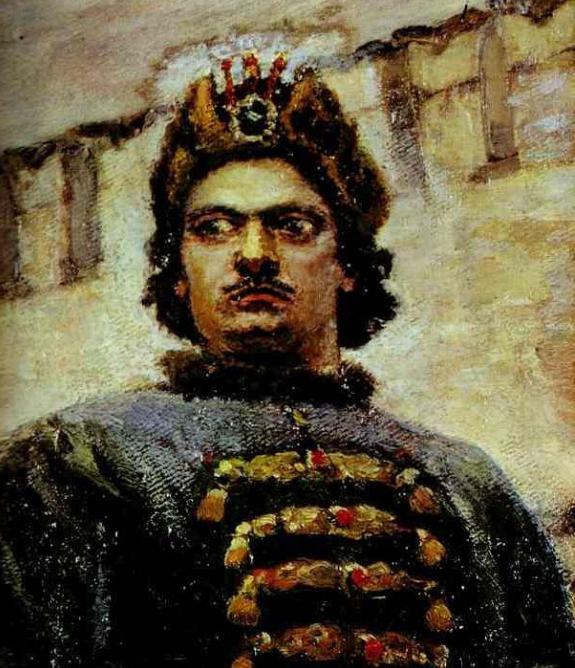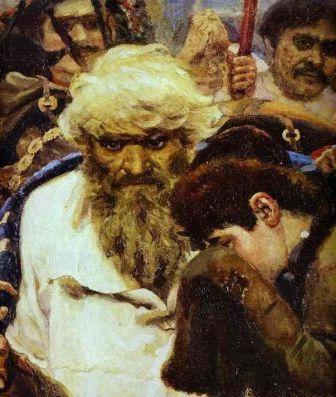The painting “The Morning of the Archery Execution” by Vasily Surikov pains an unprepared viewer. What is pictured here? It is clear that the people's tragedy: the general intensity of passions does not give reason to doubt it. Also in the picture you can see - and find out - Tsar Peter the Great. The Russian audience is probably aware of an episode from Russian history when the Moscow streltsy regiments, taking advantage of the sovereign's stay abroad, revolted. But what pushed them to this riot? And what did the artist want to say with his painting? Indeed, despite the gloomy name, the picture does not show a single hanged or beheaded. Let's try to figure it out.
The official version of events
The sister of Peter the Great, Sofya Alekseevna, imprisoned in the Novodevichy Convent, did not give up hopes to sit on the imperial throne of Russia. Taking advantage of her brother’s absence, she stated that Peter had been replaced. She urged the archers to come to her aid and protect Russia from the invasion of Gentiles (that is, European managers whom the tsar invited from Germany and Holland). 175 military men from four regiments responded to her call. They arrived in Moscow from the petition in March 1698. In early April, they managed to knock them out of Moscow, but they returned to their regiments and raised a riot. His goal was to elevate Sophia to the throne, and if she refused the kingdom - the exiled V.V. Golitsyn. The government sent four regiments and a noble cavalry against two thousand rebels. In June, the riot was suppressed, and the “most malicious instigators” were hanged. Describing the morning of the shootings, Surikov takes the official version as the basis. That is, an act of justice that happened on June 22 or 28, 1698. Then, according to the annals, fifty-six people were hanged.

Archery Execution Morning: History
In fact, mass repressions began when Peter the Great returned to Russia (August 25, 1698). The king initiated and led the re-investigation. The real morning of the shootings, described by the shocked diplomats of that time, took place on October 10. Then about two thousand archers were hanged and beheaded. Five of them, the king personally chopped off his head. He did not pardon anyone, did not look either at the floor or at age. He ordered two servants of his sisters to be buried alive in the ground. Those 500 archers who were too young, the king freed from death, but they cut their nostrils, ears, stigmatized and sent into exile. Repressions continued until the spring of 1699. The king, considered a fan of European values, allowed to bury the executed only in February.
The history of writing the canvas
So what does the painting “Morning of the Archery Execution”, which is on display at the State Tretyakov Gallery in Moscow, want to tell the audience? This is the first large canvas of Vasily Surikov, which he put on the audience. He worked on it for three years - from 1878 to 1881. Why did the artist address the topic of Russian history? Probably affected by his stay in ancient Moscow, where he moved after graduating from the St. Petersburg Academy of Arts. They say that at first the artist wanted to depict several hanged people on canvas. He even drew sketches. But one of the maids in the house, seeing them, fainted. Therefore, Surikov abandoned the idea of shocking the viewer. But the tragedy of foreboding of execution keeps us in constant tension. This feeling is stronger than seeing bloody scenes. The painting "The Morning of the Archery Execution" was liked by the collector Tretyakov. He immediately acquired it. And later he added two more works of the master on historical subjects to the collection - “Boyar Morozova” and “Menshikov in Berezovo”.

Composition
This is a large canvas (379 x 218 centimeters), oil on canvas. The painting “Morning of the Archery Execution” is designed in dark colors, which further emphasizes the tragedy and gloom of the moment. The artist resorted to an interesting technique in constructing the composition. He reduced the distance between objects in Red Square. The Kremlin tower with a wall, the Cathedral of St. Basil the Blessed and the Frontal Place immediately fit in the picture immediately . Thus, only a few dozen characters create the feeling of a huge crowd, symbolizing the Russian people. It is important that the king’s figure is in the background. So that the autocrat could be seen, the artist portrayed him on horseback. Peter the Great leads a “duel with his eyes” with one of the archers, who did not break under the yoke of repression. The king understands that he does not have power over the proud spirit of the people, and his revenge remains unsatisfied.
Color
Surikov used a rich palette for the painting “Morning of the Archery Execution”. An early autumn morning after a rainy night, when fog still hangs over the square, serves as a gray background, on which the white shirts of the convicted archers and the lights of candles in their hands more clearly appear. A bright spot attracting the eyes of the audience is a sagittarius with red hair. Although his hands are tied and his legs clasped in shackles, it is clear that his spirit is not broken. This symbolizes the highly soaring candle flame, which he squeezes in the palm of his hand. White shirts and a gray background, this grisaille softens the bright clothes of the inhabitants of those times. The little girl’s red handkerchief and the gold-woven caftan of the streltsy wife translate the viewer's eyes on the grieving people.
Symbolism
In the painting “Morning of the Archery Execution”, the artist laid down a certain code that is not understandable to everyone. The first is the number "7". Just so many archers are depicted on the canvas (one of them has already been taken away to execute - only his burning candle remains - as a symbol of his eternal soul). Seven chapters of St. Basil's Cathedral are also visible . The architectural background of the canvas also carries a hidden meaning. The strict Kremlin tower corresponds to the figure of Tsar Peter the Great, while the bright, motley heads of the church symbolize the aspirations of the Orthodox Russian people, whose executed archers were the expression of ideas.